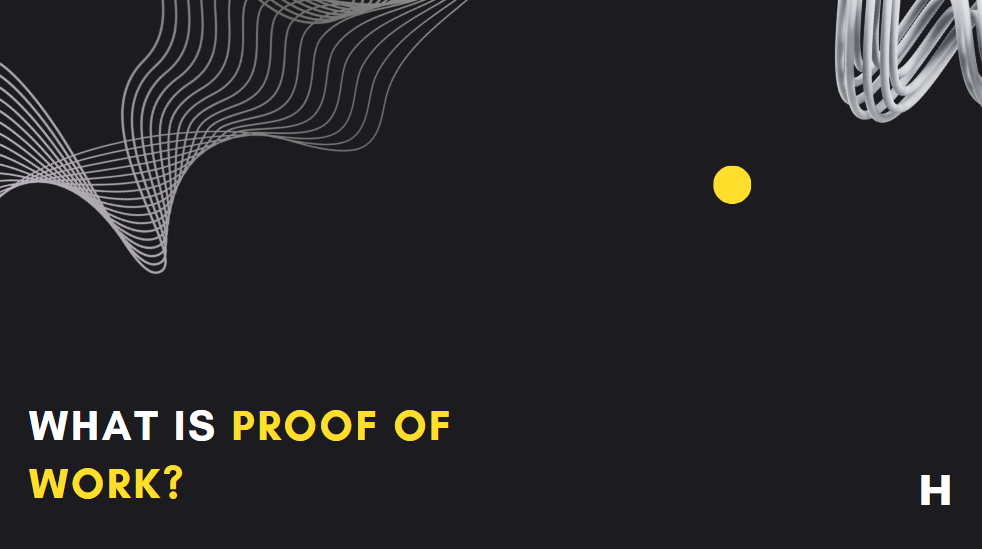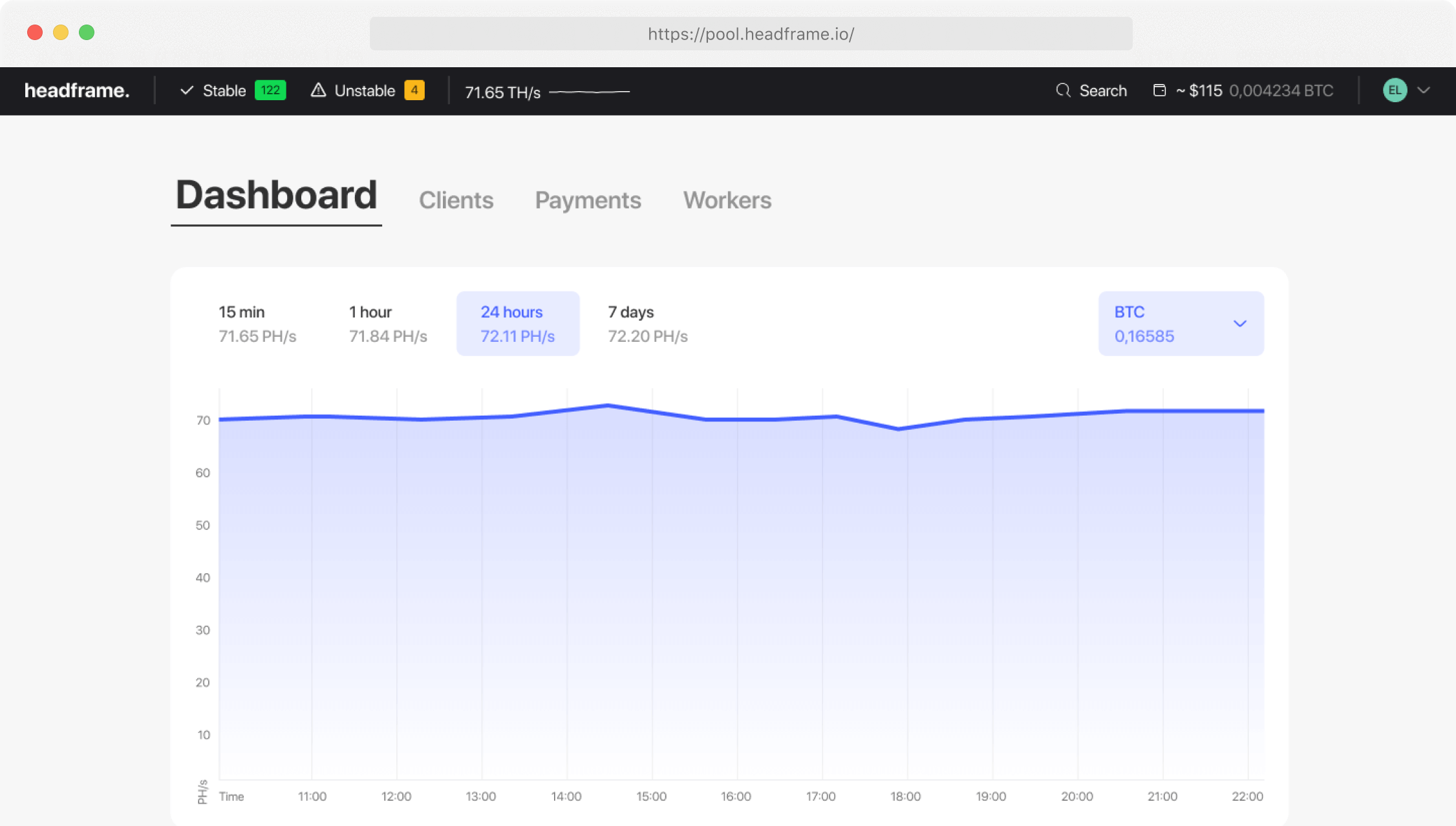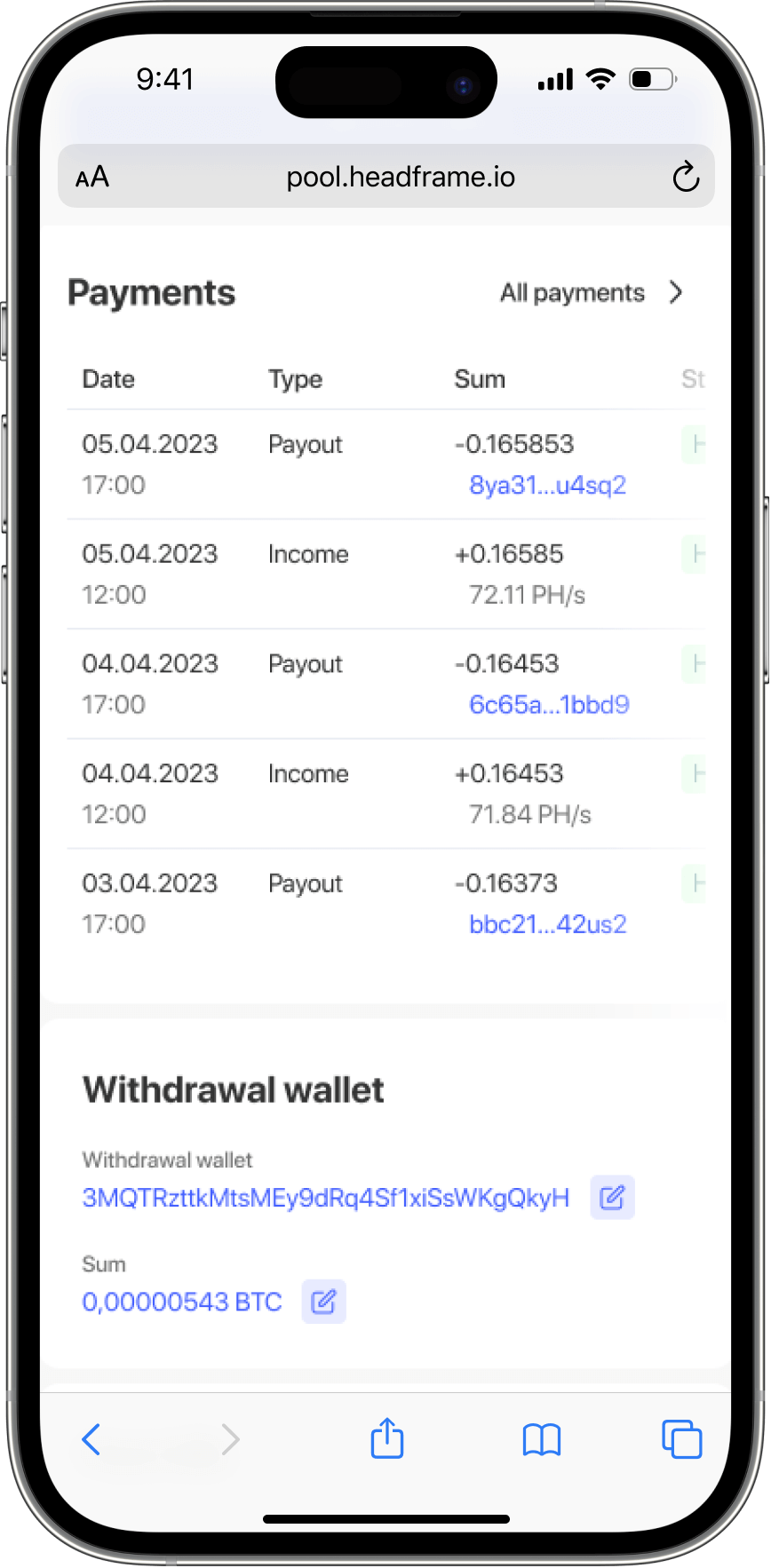
What is PROOF OF WORK?
Earn more money with Headframe
Join a mining pool and get the best profitability in mining. Already more than 10,000 miners trust Headframe.
- Proof of Work consensus mechanism: Securing the Bitcoin network
- The importance of Proof of Work in the blockchain system
- Proof of Work vs. Proof of Stake
- Proof of Stake and its potential risks
- How Proof of Work works
- Advantages and Disadvantages
- Criticism of Proof of Work
- Frequently Asked Questions
- Conclusion
Proof of Work Consensus Mechanism: Securing the Bitcoin Network
Bitcoin miners process and translate transactions into the blockchain, verifying their validity. This process involves applying a cryptographic hash function to the header of the previous block, and solving a proof-of-work (PoW) problem. The PoW mechanism was proposed by Satoshi Nakamoto as a solution to the Byzantine problem of generals, providing a reliable and objective protocol.
WHAT IS PROOF OF WORK (POW)?
Proof of Work is a method that confirms that a certain amount of work has been done to verify transactions on the network and to mine new bitcoins. The essence of this method is to use computational resources to verify transactions and integrate them into the Bitcoin blockchain, which provides trust in the decentralized system.
In the context of decentralized systems such as Bitcoin, PoW solves the problem. In such systems, nodes may encounter obstacles caused by malicious activities, software bugs, or hardware failures. These obstacles may prevent nodes from reaching consensus.
A feature of decentralized systems is the difficulty in reaching consensus, which is why Bitcoin uses the PoW mechanism. This method allows network participants to securely conduct transactions by reliably transferring data across the network from node to node. Immediately after a transaction is registered by one node, a copy of it is transmitted to all other nodes in the network.
Importance of Proof of Work in blockchain system
Proof of Work (PoW) is often underestimated due to the common perception that it is inefficient and unnecessary computational effort. Some believe that entering a transaction into a digital ledger could be faster and without additional cost. However, PoW plays a critical role in providing protection against unilateral interference.
The main value of PoW is to create additional costs for bitcoin mining, making it more secure. For example, an attack to control 51% of the Bitcoin network’s resources to create illegitimate coins or conduct fraudulent transactions is incredibly expensive. Any attempt to disrupt the integrity of the Bitcoin network would require a revision of all previously executed PoWs, and this would have to be done faster than the current network continues to create new blocks. This is what makes bitcoin resilient and resistant to change, making confirmed transactions virtually unchangeable.
To keep the PoW mining process stable and predictable, Satoshi Nakamoto developed a difficulty adjustment mechanism. This algorithm adjusts the complexity of the mining process every 10 minutes, taking into account the total processing power of the network. This prevents the premature creation of new blocks when the number of miners increases and guarantees the stability of mining even when their activity decreases.
Proof of Work vs. Proof of Stake
Proof of Work (PoW) ensures efficient use of energy to protect Bitcoin by adhering to strict rules, such as limits on the release of new coins. In contrast, Proof of Stake (PoS) focuses on scalability, which can speed up the blockchain but potentially reduce its security. The PoW mechanism in Bitcoin requires significant resources and incentivizes honest behavior of participants.
Proof of Stake, while used by most altcoins, is often advertised as an alternative to Bitcoin. With Proof of Stake, investors lock in their tokens, increasing the chances of block confirmation. However, given that many tokens were issued by developers long before they were shared, PoS may have disadvantages in decentralization.
A comparison of the two mechanisms:
PROOF OF WORK:
- Verification is performed by a network of miners.
- The adversarial nature requires a lot of energy and computing power to identify a new block.
- PoW has a real cost of mining, providing protection to the network.
- Supports economic and environmental benefits.
PROOF OF STAKE:
- Verification is done by participants with their tokens as collateral.
- Less power is consumed, but the collateral or number of coins determines the probability of confirmation.
- PoS has no real value, which can make the network vulnerable.
- The environmental benefits of PoS are limited.
Proof of Stake and its potential risks
With proof of stake, there is a risk that a participant with a 51% stake can change the protocol rules in its favor or censor the network by, for example, rejecting transactions from certain participants.
How Proof of Work works
Initially, mining via proof of work could be done using central processing units (CPUs) and graphics processing units (GPUs). However, due to the huge energy costs involved, mining is now only effectively done using ASICs (application-specific integrated circuits) controlled by miners. These devices process transaction data, information from the previous block and nonce (random number) to calculate a hash.
Hash functions convert input data into a unique output string. Bitcoin uses a SHA-256 hash function. Predicting the result of such a function is nearly impossible without the massive guessing performed by ASICs.
Miners are looking for ways to maximize the efficiency of their operations. To maximize profits, miners try to increase the number of hashes their devices can create per second, while trying to use the most economical power sources.
The complexity of Bitcoin mining is constantly being adjusted, making the process even more competitive. In simple words, proof of work can be compared to buying lottery tickets: the more tickets you have, the more likely you are to win. For example, the Bitmain Antminer S19j Pro ASIC has a throughput of 104TH/s, which equates to 104 trillion guessing attempts per second.
Since 2012, when ASICs became necessary, it has become more difficult for individual miners to mine Bitcoin. However, they can join together in mining pools to increase their chances of reaping the rewards, albeit with the condition of sharing that reward among the participants.
Advantages and disadvantages
Proof of work (PoW) plays a key role in the security, immutability, and decentralization of bitcoin. The following discusses the main advantages and disadvantages of this consensus mechanism.
ADVANTAGES
- Decentralization: a significant breakthrough in technology.
- No possibility of censorship due to decentralized structure.
- Immutability: It is virtually impossible to invalidate a blockchain.
- A system based on objectivity, strict protocol rules and the laws of physics.
- Increased security: economic incentive for miners to protect the network thanks to PoW.
- Carbon and methane capture: bitcoin recycles unused energy to create new coins and verify transactions.
- Accelerated deployment of renewable energy networks by monetizing energy through PoW, and optimizing load balancing, making power grids more efficient and reliable.
DISADVANTAGES
- Reduced transaction processing speed.
- Significant mining costs required to maintain PoW.
- PoW requires a significant amount of energy, but this is driving the development of renewable energy innovations.
Criticism of Proof of Work
A common criticism of Bitcoin concerns its high energy consumption. Since Bitcoin requires a large amount of energy to secure its network, proof of work becomes a target for criticism, especially from those who support traditional fiat financial systems.
What is often overlooked in this generalized view, however, is that Bitcoin is actually driving innovation in the clean energy and resource efficiency sector.
How exactly? In order to remain profitable, Bitcoin miners need to choose the most cost-effective energy sources. This leads to the increasing use of renewable and untapped energy sources instead of traditional fossil fuel-based sources.
RENEWABLE ENERGY SOURCES
As wind and solar become some of the most affordable sources of energy, Bitcoin miners are interested in investing in this area, which is beneficial for everyone.
A common misconception is that energy consumption is directly related to CO2 emissions. In fact, the impact on emissions is determined by how energy is produced, not how it is consumed.
WASTED ENERGY
Flaring natural gas is a prime example of inefficient use. However, when this gas is used to power Bitcoin miners, previously wasted energy becomes useful.
UNUSED ENERGY
Mining operations can be located almost anywhere, and are increasingly attracted to remote energy sources such as ocean currents or solar panels in the desert. Biogas is also of interest because it can provide a stable power supply, but is often not integrated into the main power grid.
Frequently Asked Questions
How do I adjust the proof-of-work difficulty level?
The proof-of-work difficulty is adjusted based on the speed at which miners are mining new blocks. The goal is to have a block creation time of approximately 10 minutes.
Is it possible to solve the proof-of-work problem by brute force?
The primary method of solving the proof-of-work problem is brute-force. It is a strategy that involves exploring all available solution options until an optimal one is found.
What happens to proof-of-work when all bitcoins are mined?
Even after all bitcoins have been mined, proof-of-work will serve to verify transactions and miners will be rewarded for it.
Are there effective substitutes for proof-of-work?
At the moment, for security and decentralization characteristics similar to bitcoin, proof-of-work is considered the most reliable system.
What happens if two miners find a proof-of-work solution for the same block at the same time?
In that case, the block that will be accepted will be the one that goes into the longest version of the chain, as it represents the largest amount of work.
Conclusion
Some politicians and organizations, in an effort to discredit bitcoin because of its energy consumption, may make claims that are not true. Their interest lies in maintaining the current system that works in their favor. However, bitcoin offers a new perspective on the financial system and the world at large. Proof-of-work plays a key role in this change, making bitcoin a truly valuable tool.
Source: https://bitcoinmagazine.com/guides/proof-of-work


